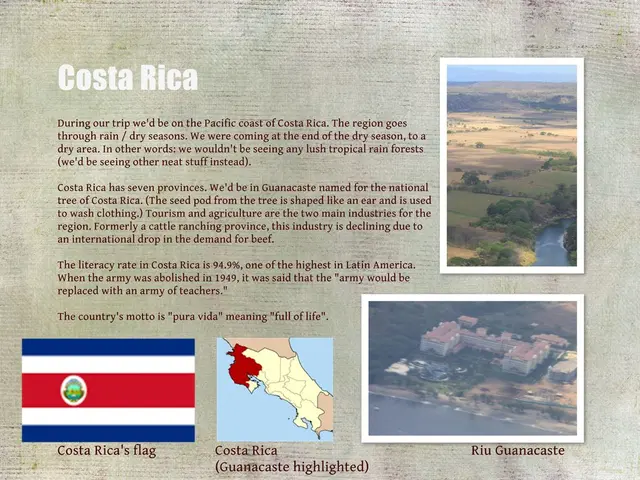The most remarkable archaeological site in Italy, found in Sicily, stands as a testament to ancient history.
Exploring the Ancient Wonders of the Valley of the Temples in Sicily
The Valley of the Temples, located near Agrigento, is a captivating archaeological site that transports visitors back in time to the heart of ancient Greece. This extensive park, spanning an impressive 1,300 hectares, is home to seven major Greek temples built between 600 and 400 BCE, all in the Doric architectural style [1][2][3].
In 1997, UNESCO recognised the outstanding universal value of the archaeological site of Agrigento by adding it to its World Heritage list [1][5].
Majestic Temples and Their Significance
The Valley of the Temples is a treasure trove of ancient history, with each temple offering a unique glimpse into the past.
- Temple of Concordia: The best-preserved temple in the valley, built around 430 BCE, it provides a nearly complete example of classical Doric architecture and symbolizes ancient Greek religion and civic life. Its state of preservation makes it the site's star attraction [1][3].
- Temple of Juno (Giunone): Known for its well-preserved Doric columns, it was one of the largest temples dedicated to the goddess Juno, significant in Greek mythology and religion [2].
- Temple of Heracles: Dating from the 5th century BCE and dedicated to the Greek god of strength and courage, this temple features nine massive Doric columns still standing amidst scattered ruins. It is located near Villa Aurea with panoramic views of Agrigento and the ocean [2].
- Temple of Dioscuri: Dedicated to the twin brothers Castor and Pollux from Greek mythology, this temple is less preserved but still notable for its foundations and a few standing columns. The site offers views over the valley and nearby Agrigento and is currently under ongoing archaeological restoration [2].
Other temples include those dedicated to Olympian gods and other notable deities, all representing the peak of Greek architectural and cultural influence in Sicily.
History and Architecture
All temples are built in the Doric order, characterized by sturdy columns with simple capitals and no bases, a reflection of classical Greek architecture's aesthetic and functional values. The Valley served as a religious and social center in Magna Graecia, reflecting the period when Greek settlers flourished economically and culturally in Sicily (circa 800–400 BCE) [1].
After the Greek period, the site passed through Roman influence; however, the temples largely remained as ruins and were preserved more recently through archaeological efforts [5].
Visiting Tips
- The site covers about 1,300 hectares, making it the largest archaeological park in Europe, so allow several hours to explore properly [1].
- It is accessible as a day trip from nearby towns like Palermo, Cefalù, or Catania, or as part of a Sicily road trip [1].
- Key highlights such as the Temple of Concordia and the Temple of Heracles are must-sees; the Temple of Dioscuri offers good shade and scenic viewpoints for breaks [1][2].
- Ongoing archaeological work means some areas may be restricted; check current site conditions before visiting [2].
- Wear comfortable walking shoes, bring water, and consider a guided tour to fully understand the historical context.
- The site includes signage and visitor facilities but planning ahead ensures a better experience [1].
In summary, the Valley of the Temples is a crucial window into ancient Greek civilization in Sicily, showcasing remarkable Doric temples that blend historical and architectural significance with stunning Mediterranean views and a rich cultural tapestry [1][2][3][5]. Today, the majestic ruins of Akragas attract history and architecture enthusiasts from around the globe.
Akragas, founded in 582 BC by Greek settlers from Gela, quickly became a thriving metropolis, rivalling the greatest cities of the Mediterranean world. However, its prosperity was short-lived, as the Carthaginians, led by Hannibal, invaded and plundered Akragas in 406 BC, marking the beginning of its decline [4]. Despite this, the Valley of the Temples has withstood the centuries and preserved the traces of its past splendour.
References: [1] Lonely Planet. (2021). Valley of the Temples. [online] Available at: https://www.lonelyplanet.com/italy/sicily/agrigento/attractions/valley-of-the-temples/a/poi-sig/1353573/394297
[2] Sicily Guide. (2021). Valley of the Temples. [online] Available at: https://www.sicilyguide.com/valley-of-the-temples.html
[3] UNESCO World Heritage Centre. (2021). Valley of the Temples of Agrigento. [online] Available at: https://whc.unesco.org/en/list/745
[4] History.com Editors. (2010). Akragas. [online] Available at: https://www.history.com/topics/ancient-greece/akragas
[5] The British Museum. (2021). The Valley of the Temples, Agrigento. [online] Available at: https://www.britishmuseum.org/collection/themes/greece/ancient-greece/sites/valley-of-the-temples-agrigento.aspx
Traveling to the Valley of Temples, a UNESCO World Heritage site in Sicily, offers an enchanting lifestyle experience, immersing visitors in the rich history and culture of the Ancient Greek civilization. En-vols (flights) to cities like Palermo, Cefalù, or Catania provide convenient access to this extensive archaeological park, home to the well-preserved Temple of Concordia, a majestic symbol of classical Doric architecture.




